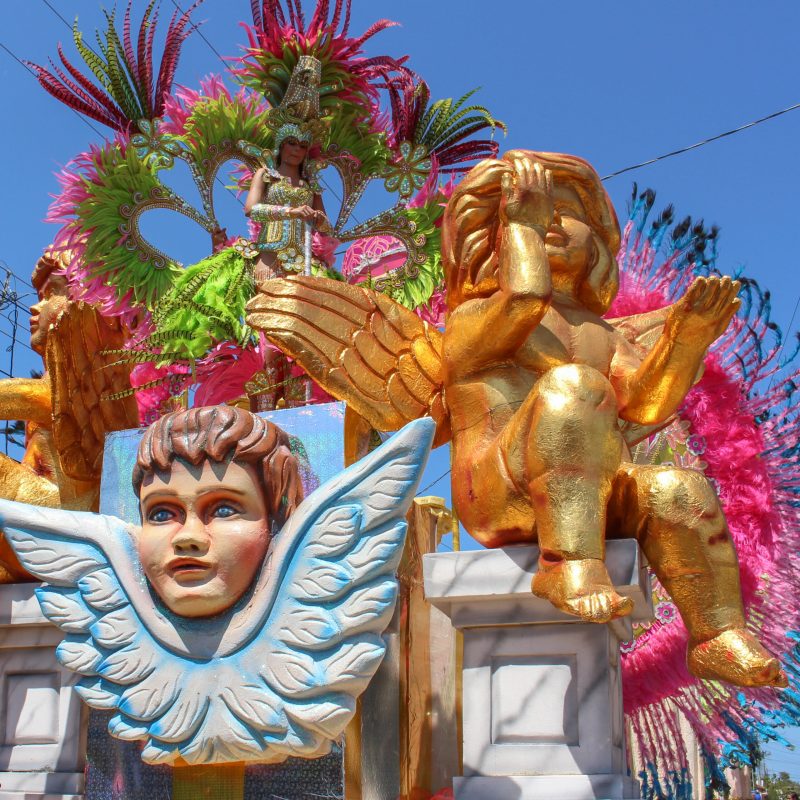
Donna Janke
Public celebrations mark the days before the somber Christian season of Lent in many countries. Each culture puts its own spin on carnival season. Carnaval in Panama takes place over the four days preceding Ash Wednesday, the start of Lent, and features street dancing, music, parades, exotically decorated floats, elaborately dressed queens, and long hours of partying. It’s colorful, lively, and loud.
Videos by TravelAwaits
Here’s what to expect when visiting Panama for Carnaval.

A Countrywide Party
Carnaval takes over the country. Although it is not an official holiday, many businesses shut down for the period. There are food and drink booths, live music events, and vendors selling souvenirs and street food. There are parades and fireworks. There are street dances. People gather in town squares, in the streets, and in their homes to eat, drink, and party until the wee hours of the morning.
Even though Carnaval doesn’t officially start until the Saturday before Ash Wednesday, in many places, the partying begins on Friday. On Tuesday, the last day, the partying lasts until dawn. Pace yourself if you want to take in as much of the festivities as possible. Early afternoon is often siesta time.
Carnaval is also a time for families to celebrate together. Many locals travel to their hometowns to observe the holiday with loved ones. I experienced Carnaval in the small town of Pedasi. It seemed as if every house in town was full of visiting relatives. The aroma of roasting chickens greeted us as we walked through the streets of town. Music emanated from houses and from massive speaker systems set up in car trunks. People visited and danced on their front porches, greeting all passersby with big waves and smiles.
Variations From Town To Town
Carnaval is celebrated in a similar manner in towns across Panama, with slight variations from region to region. Some towns are particularly known for their Carnaval celebrations.
Celebrations in Panama City are centered in Cinta Costera and Balboa. The giant street parties feature parades with floats, exotic costumes, music, dancing, and fireworks. Bocas del Toro, Panama’s party capital, is the place for serious partygoers. Carnaval festivities there are particularly spirited. Carnaval in Penonome takes an aquatic turn — the parade floats along a river.
The most extravagant celebration in the country occurs in the town of Las Tablas in the Azuero Peninsula. A rivalry between two parts of town, Calle Arriba (Uptown) and Calle Abajo (Downtown), dominates the celebrations, with parades featuring queens from each part. A similar celebration occurs in the nearby town of Pedasi, where I experienced Carnaval. I’ve read articles claiming Carnaval in Pedasi is a calmer experience than in other places, but I found the party in Pedasi to be anything but sedate.
Other towns and cities with notable Carnaval celebrations include Chitre, Los Santos, Dolega, David, Capira, Aguadulce, San Miguelito, and Ocu.

Donna Janke
A Battle Between Uptown And Downtown
In Las Tablas and many other parts of Panama, Carnaval features a “feud” between two parts of town, Calle Arriba and Calle Abajo. Each side selects a queen well in advance of the festival. In Pedasi, more and more posters promoting one queen or another were tacked up around town as Carnaval neared. It didn’t take us long to realize we were staying in Calle Arriba.
Over the course of the four days of Carnaval, the two sides compete. Each side creates elaborate floats to carry their extravagantly dressed queen and her princesses. Brass and drum bands known as murgas accompany the floats. Supporters of the queen, called tunas, follow, dancing and singing. Their rhythmic songs sounded repetitive to me at first, but they were infectious, and by the second day they made me smile and start to dance.
In Pedasi, there are two parades each day, one around noon, and the other closer to midnight. The floats and tunas of each queen start out from opposite ends of town and march toward the town square, which they circle several times. There are fireworks. At the end of the parade, the floats return to the opposite ends of town to be dismantled and recreated with new decorations for the next parade. The queens wear different costumes in each parade.
The winning queen is chosen at the end of the last parade on the morning of Ash Wednesday. It was the other side of town, Calle Abajo, that won the year I attended Carnaval in Pedasi.

Donna Janke
Colorful Dress
Parading Carnaval queens and princesses wear tiaras and glittering over-the-top costumes covered in beads and gems. Long multicolored plumes fan out behind them to the sides and above their heads.
Queens and princesses wear polleras in the last parade of Carnaval. The pollera is a traditional Panamanian dress. The handmade skirt and blouse have layered frills running from the bodice down the full length of the skirt. Consisting of yards and yards of fine fabric and decorated with colorful embroidered designs, a single pollera can take months to make and may be handed down from generation to generation.
The wearing of polleras isn’t limited to queens and princesses. In Pedasi around 6 p.m. on Tuesday evening, the last day of Carnaval, men and women dressed in traditional garb begin making their way to the town square — the women in polleras, and the men in montunas, long-sleeved embroidered white shirts worn over simple black trousers. Accompanied by a brass band, they march around the town square and center of town for hours. In Panama City, thousands march in their polleras on Sunday afternoon.
Getting Wet
Cistern trucks called culecos are a staple of Carnaval in Panama. La mojadera, or the spraying of water into the crowds from the trucks, is meant to be fun. When you’re amidst a crowd of people in hot tropical weather, it can also be refreshing.
If you want to avoid getting wet, it’s not just the culecos you’ll need to watch out for. Water guns and balloons are popular among festival attendees, especially the children. At the Pedasi Carnaval, water guns were the hottest commodity at the stalls around the town square.

Dirty Devils
You may also see diablos sucios (“dirty devils”) at Carnaval celebrations. Clad in red and/or black, they wear elaborate, scary handmade masks. The making of the masks is a traditional art. The dirty devils are a part of Panamanian folklore and are thought to ward off evil spirits. Traditionally, they carry animal bladders, which leak as they dance — hence the name “dirty devils.”
In Bocas del Toro, the dirty devils crack whips. I don’t recall dirty devils being a significant feature of Carnaval in Pedasi, although at least one member of the queen’s murga band wore a mask.
Crowds
Carnaval is a countrywide celebration, so expect to encounter crowds. If, like me, you are somewhat overwhelmed by crowds of people, you can take comfort in the fact that the colors, music, and festive vibe are likely to counteract any unease. The atmosphere is a fun one. Do, however, be careful about your personal possessions, and leave valuables behind. With all the crowds, the streets can be dirty. Don’t wear your best clothes.
Although Panama City has its own celebrations, many people travel from the city to their family homes for Carnaval. This results in heavy traffic exiting the city on the days before the festival and returning to the city after the festival.
Be prepared to pay a premium for accommodations during Carnaval, and plan to book well in advance. Prices for accommodations in popular Carnaval towns go up during Carnaval. The nightly Carnaval rate for our Aibnb in Pedasi was almost triple the non-Carnaval rate. In the days leading up to Carnaval, I noticed more and more houses offering rooms for rent.
The influx of people can overwhelm the infrastructure of some of these small towns. We encountered electrical and water outages during Carnaval in Pedasi. Neither dampened the party spirit or stopped the festivities.
Burial Of The Sardine
Carnaval ends with the Burial of the Sardine just before sunrise on Ash Wednesday, a tradition imported from Spain. Costumed mourners carry a symbolic sardine in a tiny coffin to its burial spot. As with other aspects of Carnaval, each town has its own variation on the tradition. The burial marks the end of the partying and the beginning of the 40 days of Lent.
